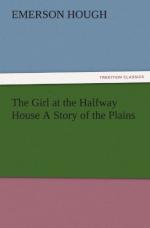There are those who sneer at the communities of the West, and who classify all things rural as crude and unworthy, entitled only to tolerance, if they be spared contempt. They are but provincials themselves who are guilty of such attitude, and they proclaim only an ignorance which itself is not entitled to the dignity of being called intolerance. The city is no better than the town, the town is no better than the country, and indeed one is but little different from the other. Everywhere the problems are the same. Everywhere it is Life which is to be seen, which is to be lived, which is to be endured, to be enjoyed. Perhaps the men and women of Ellisville did not phrase it thus, but surely they felt the strong current which warmed their veins, which gave them hope and belief and self-trust, worth full as much, let us say, as the planted and watered life of those who sometimes live on the earnings of those who have died before them, or on the labour of those who are enslaved to them.
Ellisville, after the first ball, was by all the rules of the Plains admittedly a town. A sun had set, and a sun had arisen. It was another day.
In the mind of Edward Franklin, when he was but a boy, there came often problems upon which he pondered with all the melancholy seriousness of youth, and as he grew to young manhood he found always more problems to engage his thoughts, to challenge his imagination. They told the boy that this earth was but a part of a grand scheme, a dot among the myriad stars. He was not satisfied, but asked always where was the Edge. No recurrent quotient would do for him; he demanded that the figures be conclusive. They told him of the positive and negative poles, and he wished to see the adjoining lines of the two hemispheres of force. Carrying his questionings into youth and manhood, they told him—men and women told him, the birds told him, the flowers told him—that there were marrying and giving in marriage, that there was Love. He studied upon this and looked about him, discovering a world indeed divided into two hemispheres, always about to be joined since ever time began. But it seemed to him that this union must never be that of mere chance. There could be but one way right and fit for the meeting of the two halves of life. He looked about him in the little village where he was brought up, and found that the men had married the women who were there for them to marry. They had never sailed across seas, had never searched the stars, had never questioned their own souls, asking, “Is this, then, the Other of me?” Seeing that this was the way of human beings, he was ashamed. It aroused him to hear of this man or that who, having attained a certain number of cattle or a given amount of household goods, conceived himself now ready to marry, and who therefore made court to the neighbour’s daughter, and who forthwith did marry her. To his dreamer’s heart it seemed that there should be search, that there should be a sign, so that it should be sure that the moment had come, that the Other had been found. With some men this delusion lasts very late. With some women it endures forever. For these there may be, after all, another world somewhere in the recurrent quotient which runs indefinitely out into the stars.




